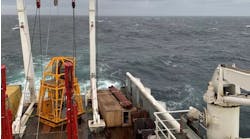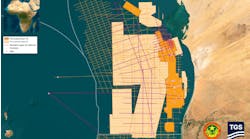This year promises to be a busy time for the Irish offshore sector. Exploration and appraisal drilling is planned for the Rockall and Erris basins, while the Porcupine basin is opening up to new licensing on a phased basis. At the same time, seven development wells are planned for two gas fields in the Celtic Sea.
The Rockall basin is Ireland's largest under-explored hydrocarbon province. Covering an area of some 150,000 sq km, it consists of a deeply subsided trough where present-day water depths plunge from 500 m along the flanks to 2,500 m on the basin floor. It contains Tertiary, Mesozoic, and perhaps older sediments.
Geoseismic section across the southern Porcupine basin between wells 43/13-1 and 62/7-1. Yellow = Tertiary, green = Cretaceous, blue = Jurassic, orange = Permo-Triassic, gray = Upper Palaeozoic, mauve = basement, red = igneous bodies.
Very little was known about the petroleum geology of the basin prior to the 1990s. Following a Petroleum Affairs Division review of the petroleum geology of the Erris and Slyne trough in 1991, the northeastern part of the basin was included in a 1994 licensing round and four blocks, frontier exploration license (FEL) 2/94, were licensed to Enterprise Oil.
PAD and Robertson Research International completed a more detailed regional study of the Rockall basin in 1996. Geophysical contractors acquired four separate multi-client 2D seismic surveys totaling almost 12,000 line km, as well as seabed geochemical and airborne high-resolution magnetic and seep detection surveys in the same year, and in anticipation of a licensing round planned for 1997. A total of 58 blocks were licensed in the 1997 Rockall round, and further proprietary 2D and multi-client 3D surveys were acquired up to 1999. Most of the 1997-licensed blocks were relinquished at the end of the first phase (June 2001) rather than to a second phase that involved drilling commitments.
Prospectivity exists within a series of perched basins along the southeastern flank of the main trough (Macdara, Padraig, North Brona, and South Brona basins), as well as in more deeply-buried Mesozoic tilted fault blocks on both the eastern and western margins of the main trough. The proposition that the basin contained a working petroleum system was based on seep detection surveys, geochemical analyses of shallow core samples, and the presence of apparent gas chimneys on seismic data.
null
Enterprise Oil drilled the first well (FEL 6/97) in the basin in 2001 on the Errigal prospect (5/22-1). It targeted Lower Tertiary reservoirs over a structural high. Spudded in 1,623 m of water, the well reached a TD of 4,070 m MD and was plugged and abandoned as a dry hole in April 2001.
The FEL 2/94 group (Shell/Enterprise, Agip, OMV) drilled the second well in the basin in 2002 on a Mesozoic target known as the Dooish prospect, 125 km northwest of the Donegal coast. The 12/2-1 well was temporarily suspended in October 2002 due to technical problems. Drilled in 1,476 m of water, the well reached a TD of 4,146 m MD and encountered a substantial column of hydrocarbons. Deep-ening and testing of the well is planned in 2003. The area is currently closed to licensing applications.
Erris basin
Statoil, as operator of FEL 5/94, is expected to drill an exploration well this year. The license lies immediately northeast of the Corrib gas field, where an estimated 1 tcf of gas is reservoired in the Lower Triassic Sherwood Sandstone.
Porcupine basin
The Porcupine basin has a long exploration history extending back to 1970 (141,000 km 2D seismic data, 2,950 sq km 3D seismic data, 30 wells). However, the rate of exploration drilling has been very low with only six exploration wells drilled in the last 20 years. To encourage further exploration, the PAD announced the Porcupine Licensing Initiative in September 2002.
PAD had first carried out a detailed review of the basin to identify remaining prospectivity. Based on that work, four tranches are being progressively reopened to licensing applications from March 15 to Oct. 15, 2004. Tranches 1 and 2 (closing dates March 15 and Oct. 15, respectively) comprise the relatively well-known central Porcupine basin and include Tertiary and Mesozoic prospects. Tranche 3 (closing date March 15, 2004) covers the northern Porcupine basin (including the Connemara oil accumulation in block 26/28), the North Porcupine basin, and the SW Slyne basin.
Tranche 4 covers the southern Porcupine basin, one of Ireland's largest offshore basins and one that is essentially unexplored (only one well, drilled in 1988). Covering an area of some 37,500 sq km (150 blocks), it consists of a rift-subsided N-S to NE-SW trending basin and lies south of the main Porcupine basin.
Present-day water depths range from 300 m along the eastern flank progressively deepening to 3,000 m in the southwestern part of the basin. Sediment fill consists of Tertiary, Meso-zoic, and perhaps older sediments, with a basin center post-Paleozoic thickness in excess of 8 km. The nearest distance to the Irish coast is 120 km.
Extensive areas of the basin have never been licensed, and the Irish fiscal regime offers very favorable terms and conditions. The closing date for bids is Oct. 15, 2004.
The exploration database consists of 2D seismic, gravity and magnetic data, seabed geochemical sampling, and seep detection surveys. Only one well, 43/13-1 spudded in 1988 by BP, has been drilled in the southern Porcupine basin proper. The well was targeting Jurassic reservoirs in a structural high. Drilled in 920 m of water, the well reached a TD of 5,128 m MD and was plugged and abandoned as a dry hole. The well had oil shows in the Upper Jurassic but encountered only poor reservoir section.
The PAD completed a new technical assessment of the petroleum potential of the southern Porcupine basin in 2002. The PAD evaluation has resulted in new prospects identified throughout the basin with illustrated seismic examples, new play and exploration ideas, and the identification of analogous leads from other North Atlantic basins. Prospectivity is seen to exist within pre-rift tilted fault blocks, syn-rift clastic fans, Tertiary mounds and Lower Cretaceous deltas and mounds throughout the basin. There is evidence to support the existence of hydrocarbon generation and leakage from satellite and airborne seep-finder data, results from geochemical analysis of seabed cores, and the presence of gas chimneys on seismic data.
Celtic Sea
Ramco plans to develop the Seven Heads gas field in 2003. In a challenging schedule, two semisubmersibles will drill and complete a total of six wells with concurrent installation of subsea equipment and pipelines. The field will produce gas via subsea manifold and pipeline to the existing Kinsale Head Alpha platform. First gas is due before the end of the year.
Marathon plans to increase depletion from the southwest part of the Kinsale Head gas field by drilling a high-angle well to intersect the A Sand reservoir. Production will again be via subsea completion and pipeline, this time to the existing Kinsale Head Bravo platform.




